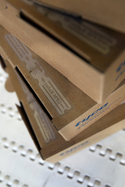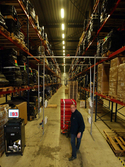RFID passes the test
4 May 2007ADT's European RFID Performance Lab in the Netherlands is one of few tailor-made environments in Europe where brand owners and retailers can test the feasibility of RFID tag application in “real-world” conditions. Jonathan Baillie reports
Established in 2005, the Lab is housed in the Echt, southern Holland. in a real-world working environment - a large warehouse supplying a vast range of goods from ADT parent company Tyco Fire & Security - ranging from fire alarms to sophisticated security systems - to customers across Europe, the Middle East and Africa. When ADT established the RFID testing facility it was felt essential it should be in a prime central European location; a strategy vindicated by the large number of brand owners and retailers that have visited in the past 18 months.
Recently David Berglund, RFID business development manager, Europe, Tyco Fire & Security, described some of the Lab's key achievements to date. Staff have, for instance, helped Tesco achieve efficient multiple reader performance in a working DC in Northern Ireland - a challenge it, and a number of other early RFID adopters, had struggled with. In another successful recent project, by deploying a sophisticated Gen 2 UHF RFID portal system, (in partnership with other hardware and software suppliers) the team has radically improved the efficiency of a Toshiba manufacturing plant in Regensburg, Germany, which configures, packages and distributes laptop computers to customers across EMEA.
Berglund said: “The Lab is Europe's first permanent RFID dense reader environment testing facility and one of only two EPCglobal-accredited test labs in Europe (the other is at the Metro Innovation Centre in Neuss). While the Metro facility is Europe's only RFID testing operation with an anechoic chamber, ADT's Lab is itself unique in being Europe's only EPCglobal-accredited conveyor portal testing site.
Alongside dense reader testing, the facility is certified for dock door RFID testing, conveyor portal testing, tag/label placement and tag/label qualification. With a small team headed by Michael Hedtke, supported by development teams in the UK and US, the facility comprises an area partitioned off from the rest of the warehouse equipped with sophisticated RFID equipment from ADT and other leading hardware and software providers.
Here companies can visit with samples of products they wish to tag, and the team will then undertake what they believe is some of the most thorough performance testing currently on offer. After determining the fundamental physical characteristics of particular tags, they will exhaustively examine the best position for tag application on pallets, cases and other containers made from a wide range of materials to “refine crucial aspects of the customer's RFID solution before deployment and help guarantee the success of their RFID application”. To date tags have been tested on everything from pallets of plastic trays and cartonboard cases to clothing.
Hedtke elaborates: “Among the areas we address is at what distance particular tags can be read efficiently from. Also, to be really thorough, so the customer is guaranteed flexibility, you can't just work with the 'best' tags; you have to test on ones offering 'average' performance. Many customers come to us with a preferred tagging location; sometimes it works, sometimes it doesn't. The type of issue we regularly address is the effect of two RFID tags or labels ending up close to eachother, for instance facing eachother on two adjacent cases. You have to remember that cases may sometimes be loaded haphazardly in such a way as to adversely affect read rates.”
Each pallet or other “collection” of tagged items tested at the Lab is subject to at least 30 runs through a portal “using every possible combination of pallet and tag positions”. To ensure customers get the most accurate feel for the performance levels they can expect, the conveyor and dock door portals incorporate sensors to measure average read speeds and conveyor speeds. All equipment is calibrated and re-calibrated regularly, while throughout each test environmental characteristics, such as the prevailing humidity, temperature and noise interference, are all regularly re-measured. Even the performance of individual portals is checked and repeatedly re-checked.
“Early in the process we also establish the reading threshold or distance the customer requires for the application and set up the hardware and software accordingly,” says Hedtke. “This is vital, as different RFID applications have very different read requirements, depending on the type of goods tagged, the environment and the speed of throughput required.”
While recognising that the Lab is already unique in its facilities, Berglund says the team is determined to establish a reputation as experts in resolving some of the technical problems which have slowed deployment.
Among the most challenging has been achieving good read performance in so-called “dense reader” environments, such as warehouses where 50 or more readers may need to operate simultaneously. (see BOXED text at end of main article)
Hedtke's team have spent considerable time since mid-last year undertaking their own extensive dense reader testing. The Lab incorporates 10 designated dense reader portals painted in yellow to distinguish them from other interrogators (the number can be increased to up to 15), together with the associated hardware and software to enable visitors to undertake dense reader testing with their own goods.
David Berglund explains: “Overcoming existing technical obstacles to multiple reader use has been a major issue for some companies, as everybody knows.” Initially the team at Echt used a six-channel plan based on synchronisation, with readers linked to the network in such a way that even if the connection goes down, reading is still possible, thanks to the use of ADT's own EOS extended operating software. More recently, however, they have moved towards a four-channel arrangement, in tandem with the work ETSI has being doing.
One of the Lab's most significant recent successes has seen the team help Tesco overcome its own dense reader challenges, Following extensive work with ADT the supermarket began in early April an eight-week RFID trial involving tagging 50,000 metal roll cages circulating in and out of its dry goods depot in Country Antrim, Northern Ireland to some 40 northern Irish outlets to gauge how effectively the technology will work on such units.
John Garrett, Tesco enterprise architect, radio barcoding, explains: “Tesco moves around one and a half billion cases annually UK-wide and, even if a tiny percentage go astray, that means significant impact to the business. We selected the Antrim DC and the 40 associated stores because they represent an effective closed loop within which we can test radio barcoding's ability to track containers arriving at the correct location and, most importantly, the wrong location, thus allowing us to truly measure loading and delivery accuracy. We are fitting readers from ADT to all 17 DC dock doors and to all the goods-in dock doors at the 40 outlets, quite an undertaking, but nothing like as complex as if we had undertaken this trial on the UK mainland, with its 2,000 stores.”
The roll cages will be tagged with specially designed tags, enclosed in a robust plastic casing, supplied Avery Dennison, while NCR will handle writing and encoding of data and application of human-readable labels to each unit. Garrett says ADT, which has supplied readers, portals and antennae to Tesco for the past three years, has been “an influential and proactive project partner”, having played a significant part in helping Tesco's own RFID team overcome the dense reader challenges. He says: “Just a year ago you couldn't have asked a large European retailer or supplier to think seriously about RFID tagging, because it was virtually impossible to get more than three readers to operate simultaneously in close proximity. However there are now many options for efficient dense reader operation, and in a recent test, when we ran a week's stock through the Antrim DC in a day, we achieved 100% reading of all the assets even with 17 dock doors reading simultaneously.”
The Tesco RFID specialist admits: “We're clearly not as far advanced with RFID as we had envisaged 4-5 years ago; what perhaps surprised us was how far from operational the standards were, and the degree to which the lengthy process of getting standards and regulations changed and implemented would delay us in being able to prove the business case. We have used this time to work with ADT and our software provider OATSystems to help evolve the non-radio aspects of their products, taking us much closer to a large enterprise-ready solution. If this trial proves successful, we may look next at dollies used to transport fresh goods, and, from there, I hope a full supply chain roll-out may be possible.”
David Berglund concludes: “It has been very satisfying to be able to help Tesco overcome some of its dense reader challenges which we hope will enable it to move to fuller deployment in due course. We believe the combination of facilities and expertise on offer at the Performance Lab is unrivalled and are delighted that several major companies have selected the Lab to conduct in-depth testing before launching RFID in their supply chains. The Echt team will continue to undertake field-leading research and testing as more companies deploy RFID and begin to reap the benefits. ADT also has an EPCglobal-accredited test lab in Florida in the US, making it the first company to have tow certified labs.”
BOX:
Current European RFID regulations limit the available spectrum for RFID reader transmission to 2MHz for operation at power levels up to 2W E.R.P (effective radiated power) and to a maximum of 10 200MHz channels within this bandwidth useable in any multiple reader environment simultaneously.
For months this seriously hampered users wishing to operate more than 10 readers in close proximity in compliance with the prevailing EN 302 208 European RFID standard, leading ETSI (the European Telecommunications Standards Institute), to develop its “listen before talk” (LBT) system, under which each reader in a “dense reader” environment must automatically “listen” before transmitting in order first to find one of the 10 available channels free.
LBT was extensively tested both by ETSI's ERM TG34 task group and RFID manufacturers. However, to improve read performance, and with large users forecasting using over 50 interrogators in one facility in future, the group subsequently explored techniques allowing over 10 interrogators to transmit on the same channel via “synchronisation”.
John Falck, heads of ETSI's ERM TG34 task group (which is examining this area), explains: “With synchronisation a higher number of readers can be linked as single system, all transmitting on one channel simultaneously. If four channels are used for readers transmitting at a power level of 2W ERP in dense reader mode this allows the others to be used by the tags.
“Normally interrogators on dock doors tend to be at least 7 metres apart, and we have found things work better if adjacent dock door readers transmit with a frequency separation of about 1.2MHz from their neighbour. To date the tests have suggested the system works well. We could not use synchronisation earlier because only with Gen 2 technology's arrival would tag capabilities allow dense reader operation.”
Initial demonstrations were undertaken last May, with a test plan compiled - fundamentally comprising comparison between the options of four and five channel plans, verification of synchronisation using 20 adjacent dock doors, and assessment of overall performance.
Subsequent “field” testing “proved the system's real-world viability”. The synchronisation tests took place at a Metro DC in Germany, using 20 adjacent portals; the channel assignments to interrogators alternated along the row of portals and were set nominally to channels 4 and 10.
A cardboard box with 30 tags mounted on one side was positioned in each portal, with each interrogator connected to a random trigger generator, which repeatedly activated each for two seconds at random over a 30-second period. The tags read were logged and the data passed to an analyser tool, which calculated reading performance and the average number of missed tags per portal. This test was repeated three times for each participant.
The same procedure was repeated with an “interferer” on channel 4, channels 4 and 7 and channels 4,7 and 10. ETSI says the results demonstrated convincingly that, even under extreme operating conditions, “synchronisation” performs satisfactorily. Furthermore, even with interference introduced on three of the four high power channels, reading performance degradation was under 1%.
Subsequent tests were undertaken to determine the technique's workability with portable readers and operational performance under high activity. Overall, the results showed the number of missed tags was less that 1.5%. After reviewing the results it was concluded the RFID industry should standardise on a common channel plan and, at a TG34 meeting, all RFID vendors agreed they would adopt a common four-channel plan.
ERM TG34 has now written a Technical Specification clarifying the way the synchronisation technique works and giving guidance on interoperability between different RFID systems.
One key challenge faced by lab staff has been ensuring that tags or labels on adjacent cases can be successfully read EPC_1 A member of the Echt warehouse team assists in setting up prior to tag testing EPC_3 The Lab is equipped with the latest hardware and software and is reportedly Europe's first permanent RFID dense reader testing facility EPC_9 Each pallet or other “collection” of tagged items tested is subject to at least 30 runs through the portal EPC_7 Tesco enterprise architect, radio barcoding John Garrett: “There are now many options for efficient dense reader operation.” JCG






